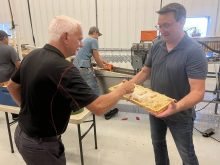A $10,000 donation to Saskatoon’s new Children’s Hospital could be the final major fundraising activity for a long-standing prairie organization.
“I’m looking at that as the last hurrah,” said Karen Gerwing, vice-president of the Saskatchewan Women’s Institute.
The money was raised through ticket sales from the group’s annual quilt raffle and is expected to be presented to the hospital in May.
“If we can get our name on a plaque at the children’s hospital, I think that’ll be one of the last things that we get to do in Saskatchewan,” she said.
Read Also

Vintage power on display at Saskatchewan tractor pull
At the Ag in Motion farm show held earlier this year near Langham, Sask., a vintage tractor pull event drew pretty significant crowds of show goers, who were mostly farmers.
Attrition has been taking its toll and Gerwing said the majority of the 35 current provincial members are older than 70.
At 55, the retired schoolteacher said she brings the average age down, but younger women are not joining the organization, which began in 1911.
There are currently 660 branches distributed throughout 10 provinces, with most of their 7,000 members in Ontario.
Organizers across the country have been seeing membership trending downward over the past decade, but not as fast as in Saskatchewan.
Unlike in other provinces, where the WIs were run and funded through the departments of agriculture, Gerwing said the Saskatchewan WI originally began as a homemakers club in 1911 and was financed through the extension office division at the University of Saskatchewan.
As a result, most Saskatchewan members were retired teachers, whereas other provinces concentrated more on farm women and the agricultural side.
“That’s the big difference with the Saskatchewan WI. We had funding and we were cut and lost our office out of the university 20 years ago already,” she said.
There are only two remaining branches left operating in the province: Foam Lake’s Briar Mound club is more than 100 years old, as well as Fort Qu’Appelle’s Prairie Lilies, which was formed 15 years ago.
She said Manitoba and Alberta WIs, while also declining, still have hundreds of members.
Women’s Institutes were originally set up throughout Canada to help empower rural women to make a difference for their families and communities.
Their motto: “Women inspired to make change count.”
“It’s fellowship for women, but it’s still supposed to be the education and advocacy for and the empowering of women,” she said.
However, the internet has been both a blessing and curse, according to Wendy Hamilton, executive director of the Federated Women’s Institute of Canada.
“People can now do it virtually,” she said.
With the advent of social media, particularly in the past five years, there are different modes of communication to engage in, which has allowed for increased education and access.
“When you’ve had an organization that’s been around for 100 plus years and they’ve been used to doing things — it’s the time frame to evolve into some of these new formats,” she said.
But the Women’s Institute is not alone in trying to adapt to a new world. Whether it be not-for-profit, volunteer or charitable, many sectors are struggling with the changes in what people are looking for regarding their efforts, involvement and how they want to get engaged.
“Women are joining organizations differently than they have in the past,” she said.


















